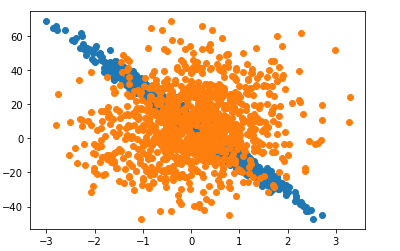1、自己创建一个2维线性回归数据集
import torch
from matplotlib import pyplot as plt
import random
import traceback
# create data
def create_data(W, b, num):
X = torch.normal(mean=0, std=1, size =(num, len(W)))
y = X.matmul(W) + b
# 加点噪声
y += torch.normal(mean=0, std=0.1, size=(num,))
return X, y
def plot_scatt(x, y):
plt.scatter(x, y)
W_true = torch.tensor([3, -20.5])
b_true = 8
data_num = 1000
features, labels = create_data(W_true, b_true, data_num)
plot_scatt(features[:, 1], labels)
plot_scatt(features[:, 0], labels)
def get_batch(X, y, batch_size):
input_size = len(X)
index = list(range(input_size))
random.shuffle(index)
for i in range(0, input_size, batch_size):
batch_indices = torch.tensor(index[i: min(batch_size+i, input_size)])
yield X[batch_indices], y[batch_indices]

2、回归
import math
W = torch.normal(mean=0, std=0.01, size=(2,1), requires_grad=True)
b = torch.zeros(1, requires_grad=True)
# model
def target_func(X, W, b):
return X.matmul(W) + b
# loss
def cal_loss(y, y_, batch_size):
# print(y, y_, batch_size)
return ((y - y_.reshape(y.shape)) ** 2 /2).sum()/batch_size
# sgd
def sgd(params, lr):
with torch.no_grad():
for param in params:
param -= lr * param.grad
param.grad.zero_()
# 训练过程
epochs = 30
batch_size = 10
lr = 0.003
for i in range(epochs):
for X, y in get_batch(features, labels, batch_size):
loss = cal_loss(y, target_func(X, W, b), batch_size)
loss.backward()
sgd([W, b], lr)
with torch.no_grad():
loss = cal_loss(labels, target_func(features, W, b), len(labels))
print("loss", loss)
print(f‘w的估计误差: {W_true - W.reshape(W_true.shape)}‘)
print(f‘b的估计误差: {b_true - b}‘)
def plot_linear(x, y, w, b):
plt.scatter(x, y)
yy_list = []
for xx in x:
yy_list.append(w * xx.item() +b.item())
# print(yy_list)
plt.plot(x, yy_list)
# print(W[1].item())
plot_linear(features[:, 1], labels, W[1].item(), b)
plot_linear(features[:, 0], labels, W[0].item(), b)

原文:https://www.cnblogs.com/pyclq/p/14721633.html